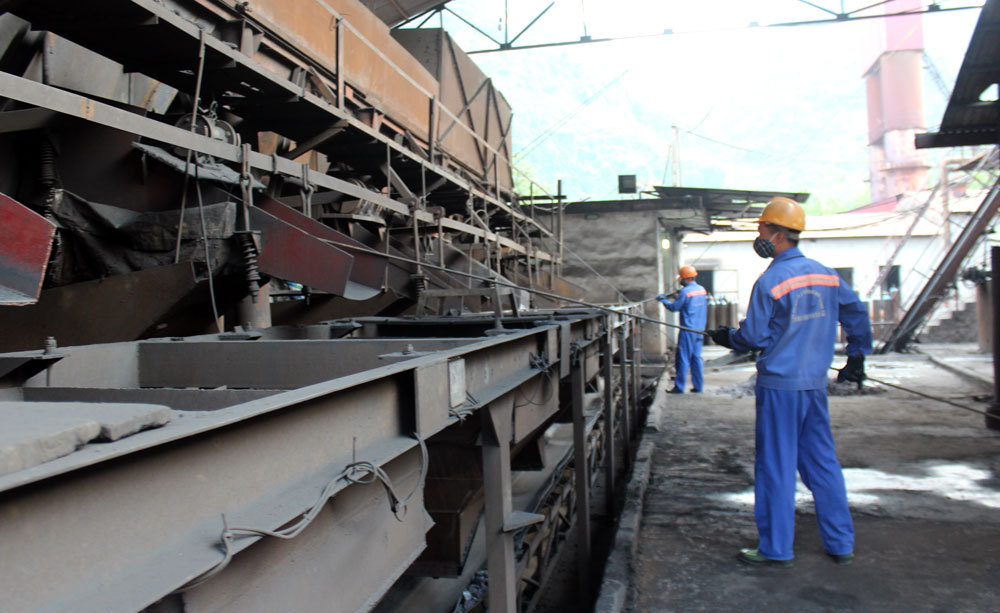
In recent years, the industrial sector in the province has grown strongly with synchronous and modern infrastructure, attracting many large-scale projects. However, the industrial clusters have not been developed commensurately. The shortcomings and weaknesses in its development have been pointed out by relevant levels and sectors to find out the suitable solutions, thereby, further promoting the potentials and strengths of the industrial sector.
Lots of planning, low efficiency
Thai Nguyen has 35 industrial clusters planned with a total area of 1,259 hectares. In which, only 16 clusters have infrastructure investors, 24 clusters have detailed planning, 15 clusters have been put into operation with a total registered capital of over VND1,200 billion. The average occupancy rate of operating clusters are about 44%, attracting 71 investment projects and creating jobs for over 8,800 employees. In the past 5 years, only 11 projects have been granted investment registration certificates in industrial clusters (1 FDI project). The above figures partly show that the investment result at industrial clusters is quite modest compared to its potential and expectation.
The actual investment result shows many difficulties. The basic infrastructure of industrial clusters, especially the infrastructure outside their fence, is not synchronized and patchy due to the investor's weakness in capacity while the support capital from the budget is very limited. The industrial clusters planned in mountainous and highland districts faced many difficults on attracting investors and build their infrastructure. Many industrial clusters have not been implemented, such as: Du - Dong Dat Industrial Cluster, Phu Luong district; Nam Hoa Quang Trung - Chi Son and Dai Khai, Dong Hy District; Phu Lac, Dai Tu District; Ban Dat, Phu Binh district...
Mr. Tran Anh Son, Head of the Industrial Management Department (Department of Industry and Trade), said: The main reasons of the above difficults are inconvenience for traffic, the lack of raw materials and labor. There was a period when the planning of industrial zones was divided equally among localities without prioritizing favorable factors.

The production line of Trong Tin Investment and Trading Joint Stock Company at Truc Mai Industrial Cluster which is one of two operating industrial clusters in Vo Nhai District
Adjust for breakthrough
In recent years, the provincial leaders has directed relevant levels and branches to adjust and supplement the industrial clusters’ planning. Last March, the Provincial People's Committee issued a Decision on adjusting and supplementing the industrial clusters planning until 2020, towards 2030, to match the actual situation. According to this decision, 5 industrial clusters are removed from the planning with a total area of 202 hectares, 3 clusters reduce nearly 80 hectares (most of them are in mountainous districts where traffic is difficult). At the same time, 5 new industrial clusters were added with a total area of 356 hectares in Phu Binh and Pho Yen districts, including: Thuong Dinh, Hanh Phuc - Xuan Phuong, Minh Duc 1, Tan Phu 1 and Tan Phu 2.
This Decision shows the shift in industrial clusters’ planning from disadvantaged areas to localities with better infrastructure conditions and potentials to attract investment. It also concretize the Resolution of the 20th Provincial Party Congress, term 2020-2025 (focusing on infrastructure development of the southern industrial clusters), in line with current actual conditions and development direction in the coming years.
Last April, the Provincial People's Committee awarded the Decision to establish Tan Phu 1, Tan Phu 2 (Pho Yen Town) and Luong Son Industrial Cluster (Song Cong City). Saigon Telecommunications Technology Joint Stock Company (Saigontel) which a leading enterprise in Vietnam in terms of infrastructure development, foreign investment attraction is these industrial clusters’ infrastructure investor. Mr. Dang Thanh Tam, Saigontel’s Chairman of the Board of Directors said: “We are committed to deploying on schedule in 2 years and attracting quality investors into these industrial clusters. The authorities at all levels of the province are dynamic and create favorable conditions, so we are very satisfied. In addition, according to our research, many industrial clusters are planned newly but already have made proposals by investors.
Currently, the localities are reviewing and proposing to adjust and supplement the planning of industrial clusters. After that, specialized departments and branches will appraise, advise and update to the provincial planning. Along with that, the appraisal and selection of truly capable investors are increasingly concerned by all levels and sectors. These solutions are expected to create a breakthrough in the development of industrial clusters in the province in the near future.




.jpg?width=300&height=-&type=resize)
.jpg?width=300&height=-&type=resize)
.jpg?width=300&height=-&type=resize)
